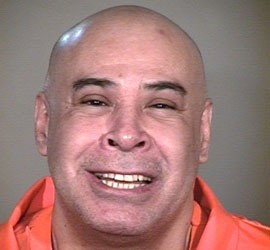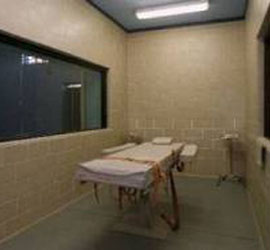Cronkite News has moved to a new home at cronkitenews.azpbs.org. Use this site to search archives from 2011 to May 2015. You can search the new site for current stories.
State could tie execution record in 2012, and pace likely to continue
Editor’s Note: The sidebar that moved previously with this story misspelled the name of one of the court cases that had an impact on the imposition of the death penalty. Baze v. Rees was a Supreme Court case out of Kentucky that upheld lethal injection as a means of execution. The sidebar here has been changed to reflect the correction.
WASHINGTON – When prison officials pronounced convicted killer Samuel Lopez dead from a lethal injection at 10:37 a.m. Wednesday, it was the fourth execution in Arizona in the first six months of this year.
At that pace, the state could be on track to match its record of seven executions in a single year, said legal experts.
And with 125 inmates on Arizona’s death row and no major legal challenges to slow the rate of executions on the horizon, they said they don’t expect to see the numbers start dropping anytime soon.
“This pace may continue for a while,” said Andy Silverman, a University of Arizona law professor.
A fifth execution, of convicted murderer Daniel Cook, is currently slated for Aug. 8 and at least two more are possible before the end of the year.
There is an outside chance of others, but attorneys familiar with the system said they did not expect those cases to finish moving through the courts until sometime next year.
There have been only 13 executions in the state since 1999, but most of them took place since 2010: Three in 2000, one each in 2007 and 2010, followed by four last year and four so far this year.
The increase comes as a series of legal challenges that had long stalled executions in the state have been cleared away, opening the door to the increase in executions.
Experts say the biggest legal challenge was Ring v. Arizona. That case went all the way to the U.S. Supreme Court, which ruled in 2002 that only juries could weigh the aggravating factors that determine whether a convicted criminal in a capital case should get the death penalty. Previously, judges had that power.
The court’s decision could have sent scores of death row cases back for resentencing and many cases were put on hold until a later court decision clarified which cases Ring could be applied to.
“Once Ring was resolved, the cases started to move again,” said Dale Baich, an assistant federal public defender in Arizona.
“If the trend continues and death sentences are not vacated along the way,” executions could continue at a similar pace for some years, Baich said.
Arizona Rep. Cecil P. Ash, R-Mesa, said that would not necessarily be a problem for those of his constituents who believe it can take too long to carry out a death sentence in the state.
While he knows there are death-penalty opponents, he said, “For those that support capital punishment, they feel it takes too long.”
The Department of Corrections said that since 1937, an inmate on death row spends an average of 12 years there, but most officials say the number now is closer to 20 years.
“I know my constituents are concerned it takes too long,” said Ash, who said he asked the Legislative Council early in his career what could be “done to accelerate the process.”
Baich’s counterpart is Kent Cattani, chief counsel of criminal appeals for the Arizona Attorney General’s Office. While Baich defends death row inmates, Cattani argues for the state.
Cattani said there are currently 49 Arizona death penalty cases pending in the 9th U.S. Circuit Court of Appeals, the last stop before the U.S. Supreme Court. Two of those cases have been affirmed by the appeals court and are awaiting Supreme Court review, but Cattani said it would be “unusual” if the high court agreed to hear those cases.
“From the time the 9th Circuit decision is announced, it’s usually about a year till an execution is carried out,” Cattani said.
He said he believes two cases – those of Richard Stokley and Edward Schad – are far enough along in the process that they could be finished before year’s end.
While they can make educated guesses based on the progress of legal proceedings, both Cattani and Baich caution that predicting the number of executions in a given year is an impossible task.
Baich’s guess is that “if the trend continues and death sentences are not vacated along the way,” executions in Arizona will continue at the current pace for some years to come.
Nationally, there has been a fairly steady decrease in executions, from 98 in 1999 to 43 in 2011, according to the Death Penalty Information Center. Because of the lag in carrying out death sentences, a center official said executions being carried out now are more of a reflection on the past than the present.
“Executions reflect not so much the attitudes and trends right now, but 10 or 15 years ago,” said Richard Dieter, executive director of the center, a national anti-death penalty group.









